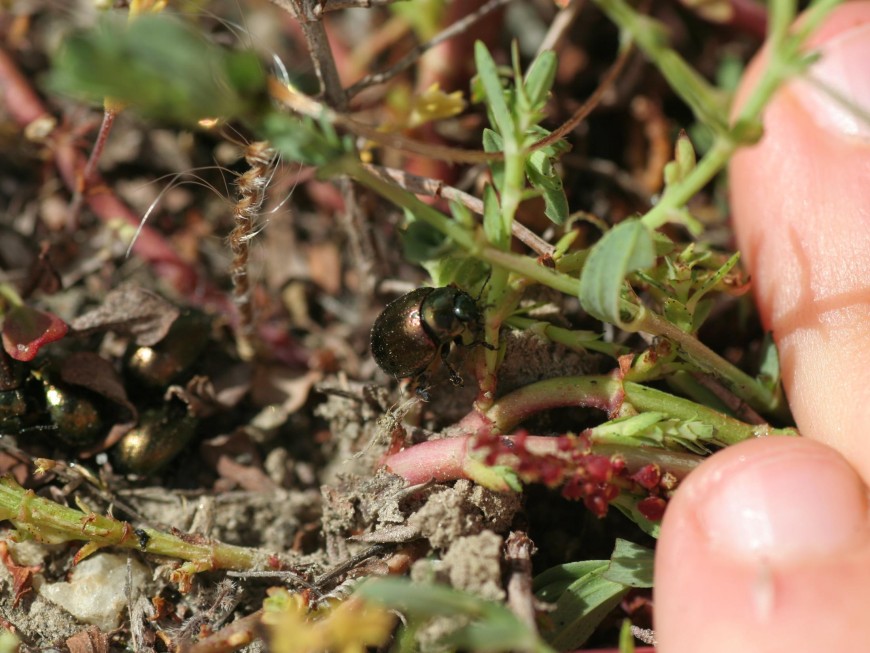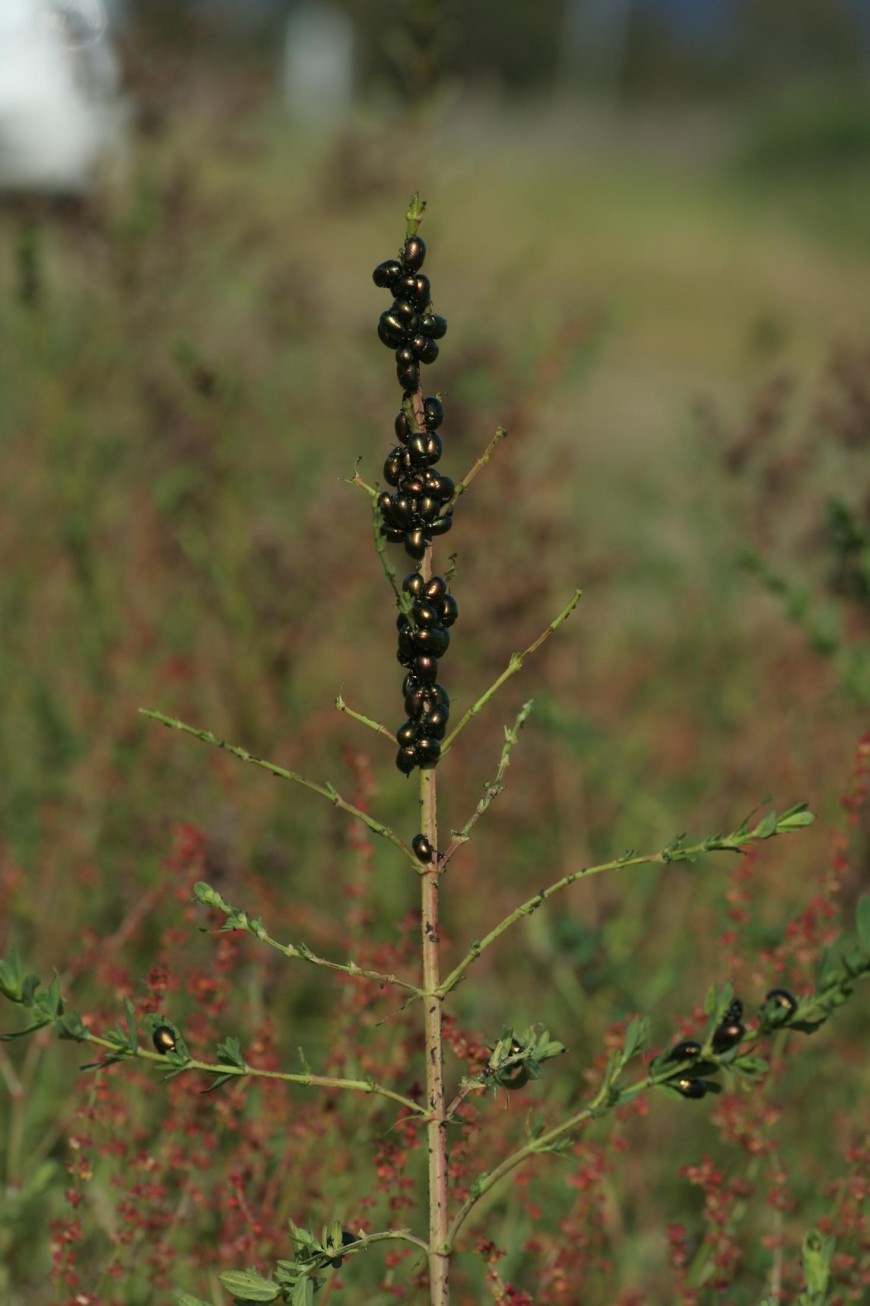The Economic Benefits of Two Beetles

Image: St John's wort beetle.
The reprieve from St. John’s wort is thanks to two chrysomelid beetles, the lesser St John’s wort beetle (Chrysolina hyperici), and the closely related greater St John’s wort beetle (Chrysolina quadrigemina), released in New Zealand in 1943 and 1965 respectively. Only 4 years after release, the lesser St John’s wort beetle, alone, was recorded to have cleared over 180 ha of the weed in the Marlborough district. Although evidence is mostly anecdotal, insecticide exclusion experiments in New Zealand indicated higher densities of St. John’s wort in the absence of the beetles. Another study reports that small infestations appearing after disturbance, or plants grown for medicinal purposes, are quickly colonised and destroyed by the beetles.
Image: an insecticide exclusion trial showing the impact of the beetles.
Recently, two of our weed biocontrol researchers, Simon Fowler and Ronny Groenteman, along with James Barringer (MWLR – Informatics) and Grant Humphries (Black Hawks Data Science Ltd., Scotland) revisited the history books to conduct an ex-post economic analysis of this most spectacular programme. “This is the second ex-post economic analysis of weed biocontrol in New Zealand after ragwort (Jacobaeae vulgaris). Other economic analyses of weed biocontrol in New Zealand have been ex-ante, assessing possible benefits of future weed suppression,” explained Simon. “The analysis was multifaceted, pulling together predictions on expected modern day geographic range and past spread of St John’s wort, with data on economic losses caused by St John’s wort, and comparing this to annual investment in weed biocontrol research (all cost adjusted for the year 2022),” he added.
The starting point was to estimate the spread of St John’s wort by 2022 if biocontrol had never been implemented. There was very little historical data on the extent of St John’s wort pasture invasion, and what little information was available confirmed that it had probably not reached its maximum potential range when the biocontrol programme was first started in 1943. So the team had to make some inferences. The expected range of St John’s wort for the present day was simulated using ecological niche modelling overlaid with GIS-mapped land-use vulnerabilities to model the potential range of St John’s wort in South Island pastures that would have been affected economically by the weed. Overall, 660,000 ha was the final estimated figure of maximum saturation, which would have been reached just after 1989 in the absence of biocontrol.

Image: St John's wort beetles feeding.
Next, production losses (using stocking rate data reported for extensive South Island sheep farms) were calculated, along with estimates of the predicted pasture displacement that would occur. The amount of return a farmer can make off the land was estimated at $65.48/ha (2011 value), and it was conservatively assumed that farmers would make efforts to control the weed, but with serious infestations would still lose 30% of their productive land to St John’s wort. Overall, we predicted that total annual losses to South Island farmers from St. John’s wort in the absence of biocontrol would have been $0.119 million in 1940, increasing logistically to $15.7 million in 2022 (with both figures at 2022 rates).
The next piece of the puzzle was working out what NZ had invested in SJW biocontrol over the years. The team used excellent historical records of NZ biocontrol activity to estimate the cost of the programme started in 1943 and ran intermittently until 1993.
“To work out the present value (PV), each annual productivity loss, or biocontrol cost, was inflated at 4% each year, from when it occurred through to 2022,” explained Simon. “We then calculated the net PV benefit of biocontrol as the cumulative PV of annual productivity losses (1940–2022) without biocontrol, less the cumulative PV of annual productivity losses (1940–2022) with biocontrol,” he added. The benefit–cost ratio is then calculated as the net PV benefit of biocontrol divide by the total cumulative PV of biocontrol costs.
The final results of the cost benefit analysis showed that biocontrol of St. John’s wort provided an ongoing, annual national benefit, in terms of improving pasture productivity, of $15.5 million in 2022. To put this saving in perspective, NZ’s current annual investment in all weed biocontrol is around $1.34 million (i.e. just 9% of the ongoing annual benefit that NZ is receiving from the SJW biocontrol programme alone). The PV analysis shows that the 2022 benefit-cost ratio was 6254:1: i.e. NZ has gained $6254 for every $1 invested in SJW biocontrol. All these analyses were robust to substantial sensitivity testing.
As with all such historical analyses, there are uncertainties and caveats. For example, we cannot be certain whether biocontrol was responsible for all the reductions in St. John’s wort, and whether the biological suppression of St. John’s wort led to any secondary weed invasion of pastures. Nevertheless, it does seem certain that the benefits of biocontrol of St. John’s wort to NZ have been huge, and are self-sustaining. Of course, the benefit that NZ continues to get from SJW biocontrol can be so easily overlooked when we are no longer confronted with SJW as a weed problem!
This project was funded by Manaaki Whenua – Landcare Research’s Beating Weeds Programme, which is funded by the Ministry of Business, Innovation and Employment’s Strategic Science Investment Fund (MBIE-SSIF).
